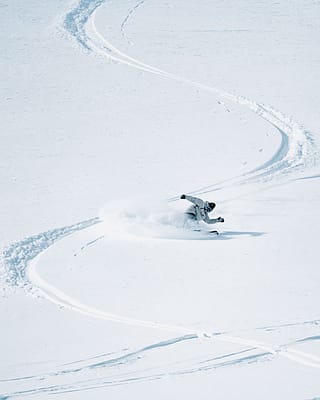How to practice snowboarding at home
So, you’re feeling rusty and worried about the season opening. Don’t worry, us too. That’s why we’ve put together this slick little guide to practice snowboarding at home and hit the, er, snow running.

When it comes to off-season practice, not all of us have the luxury of hitting Mt. Hood’s summer stomping grounds or heading below the equator to soak up some sunny laps in NZ. For most of us, it’s calendar and webcam watching, lamenting bygone winters, and praying to all heck we’re not too out of shape come December.
But just because you can’t actually ride during the off-season doesn’t mean you can’t hone your skills, right? Plus, your gear doesn’t have to gather dust until the snow falls. So, we scoured the internet and pulled together our top eight tips to practice snowboarding at home and make sure you’re ready to ride on opening day. You’ll have everything you need to get off on the right foot — or the left if you ride regular. Get it?
Already ahead of the curve on physical prep? Why not get your gear ready for winter by checking out the new snowboard jackets and snowboard pants on the MONTEC store?
Top 8 tips to practice snowboarding at home
Get comfortable with your gear
Practice flexibility
Improve cardiovascular health
Begin strength training
Buy a balance board
Research techniques before your trip
Perfect techniques on grass
Prepare yourself mentally
8 tips to practice snowboarding at home
We're about to embark on a fun journey, right here, right at home. With a little creativity, our living rooms (and backyards) can become our personal training ground. Besides, practice makes perfect, right? Below are eight handy tips to keep your snowboarding stoke high and skills sharp, so you're ready to go when the first snowflake falls.
1. Get comfortable with your gear

Remember last winter when you strapped in for the first time and thought: ‘Oh crap, my knees don’t bend this way’? Or, ‘How the hell was this ever comfortable?’ Well, what if we told you there’s a way to avoid that?
Cramming your feet into your boots doesn’t have to be reserved for the parking lot on opening day. Instead, wear your boots for just an hour a day leading up to the season to help get back into the swing of things.
Then, strap in. Just get on your board and start moving around. You can flex the thing and get used to the weight again, squat until your knees and hips don’t hurt and crack anymore, and, of course, practice walking penguin, so it’s not a total embarrassment on day one.
2. Practice flexibility
Warming up your boots is one thing. However, what about the first time you try to grab nose again and realize you can’t even reach your knee, let alone your board? This is where practicing your flexibility comes in.
When snowboarding, your knees, hips, and back are the most important things to keep supple. Sumo Squats are one of the best exercises to get started on all three. You can do them unweighted – varying your foot width and angles – and bending forward to engage your back, too.
Upward Dog is always an excellent pose for the back, as is Warrior One. For more lateral movement, try Warrior Two, and then slowly lower your back hand towards the back foot. Repeat until the pain disappears, alternating sides to ensure you stretch equally.
3. Improve cardiovascular health

This one’s a no-brainer. If you forgot that snowboarding can be a workout, we forgive you. Luckily, cardio is a fantastic way to help. Plus, you can easily combine the previous and next tips with this one for added efficiency.
Running is excellent for keeping up your cardio. But, if you don’t like running (like most of us!), hiking is the perfect way to connect with nature and build some cardio.
If you’re trying to work up a sweat, go with burpees and kettlebell workouts. These help build dynamic strength and train mobility while also getting the heart pumping and the lungs working hard.
4. Begin strength training
When it comes to strength training, focus on three things. First is plyometrics to supercharge your joint and tendon strength and mobility. Then, it’s complex workouts, which engage multiple muscle groups. Lastly, it’s to-failure training.
Plyometrics can supercharge your explosive strength, but it’ll also make your joints much more resilient, helping to avoid injury. There are hundreds of exercises you can check out, but the long and short of it is implementing short, burst movements that cut down the risk of an ACL or Achilles injury. So go do them!
Complex workouts like full-body kettlebell workouts will hit you for mobility, flexibility, cardio, and strength, so we recommend getting a kettlebell if you don’t have one! To-failure training could be planks, squats, or anything else to help prep your muscles for riding. Just squat, and keep squatting until you can’t anymore. It’s called to-failure for a reason!
5. Buy a balance board

You may not realize it, but your balance will be a little wonky when you get back on your board. Luckily, balance boards are a great way to get into the riding position and practice your balance.
You can go for one of the fancy ones with the bindings and straps to really simulate being on snow. Alternatively, you can keep it low-key and use a skateboard without wheels or even just a plank of wood.
Easy mode is balancing on something triangular with a solid base. Hard mode is balancing on something cylindrical that rolls. Try one, then the other, and be amazed at how much it helps your riding – especially if you like to jib and hit rails!
6. Research techniques before your trip
We could all benefit from a little more tuition, and riding is no exception. Many great YouTube channels offer amazing videos explaining everything from the basics of linking turns to how to Cab Triple off the money booter.
Brushing up on things like correct body positioning and movements is a nice way to ease back into riding. Plus, as you’ve ridden a bunch, you’ll be able to visualize what you’re doing, which will help when you get on the snow.
And if nothing else, you’ll be able to set yourself some goals for the coming season. For example, want to finally land that Back 3 clean? Want to throw some Wildcats? Or maybe you finally want to hit that rail you’ve been eyeing? You’re never too good to take some tips from a pro!
7. Perfect techniques on grass

This is a personal favorite. It’s great for getting your presses and butters dialed in and prepping your body for the unique stresses and pressures of snowboarding.
Find a nice piece of grass, get your boots on, and strap in. Then, practice some sustained tail presses and nose presses. Rock back and forth, trying to hold your press for as long as possible before putting it down.
You can also practice popping and ollying, which you’ll need when hunting side hits. And, of course, getting your 180s and 360s on lock on the flat ground will massively benefit your time on snow!
8. Prepare yourself mentally
This is our final tip, and it’s a simple one! Snowboarding is so fun and can be very relaxing, but it also comes with challenges. If you’re learning new tricks, exploring new terrain, or just want to ride to the best of your ability, it’s a mental game as much as a physical one.
Checking out some YouTube videos, practicing on flat ground, and incorporating some more strength and exercise training into your routine are all things that will take some mental focus and willpower to achieve. So, to truly get a jump-start on winter and practice your snowboarding at home, you need to adopt a state of mental dedication.
Get your mind where it needs to be, and you’ll have no trouble with the physical aspects. Mental toughness is at the core of consistency, so don’t overlook it!
Wrapping up
Well, there it is: the quick and dirty on how to prep for this season! Of course, we didn’t dive too deep into any one topic, and that’s because everyone’s different. For example, you might already be super fit and strong or use a balance board every day for fun. You know what they say: don’t teach your granny to suck eggs. We won’t, but hopefully, we can teach her how to snowboard.
Pray for snow, everyone, because winter is always just around the corner! Like this article, or think we missed something vital? Hit us up at crew@montecwear.com and let us know!
Related Reading:
